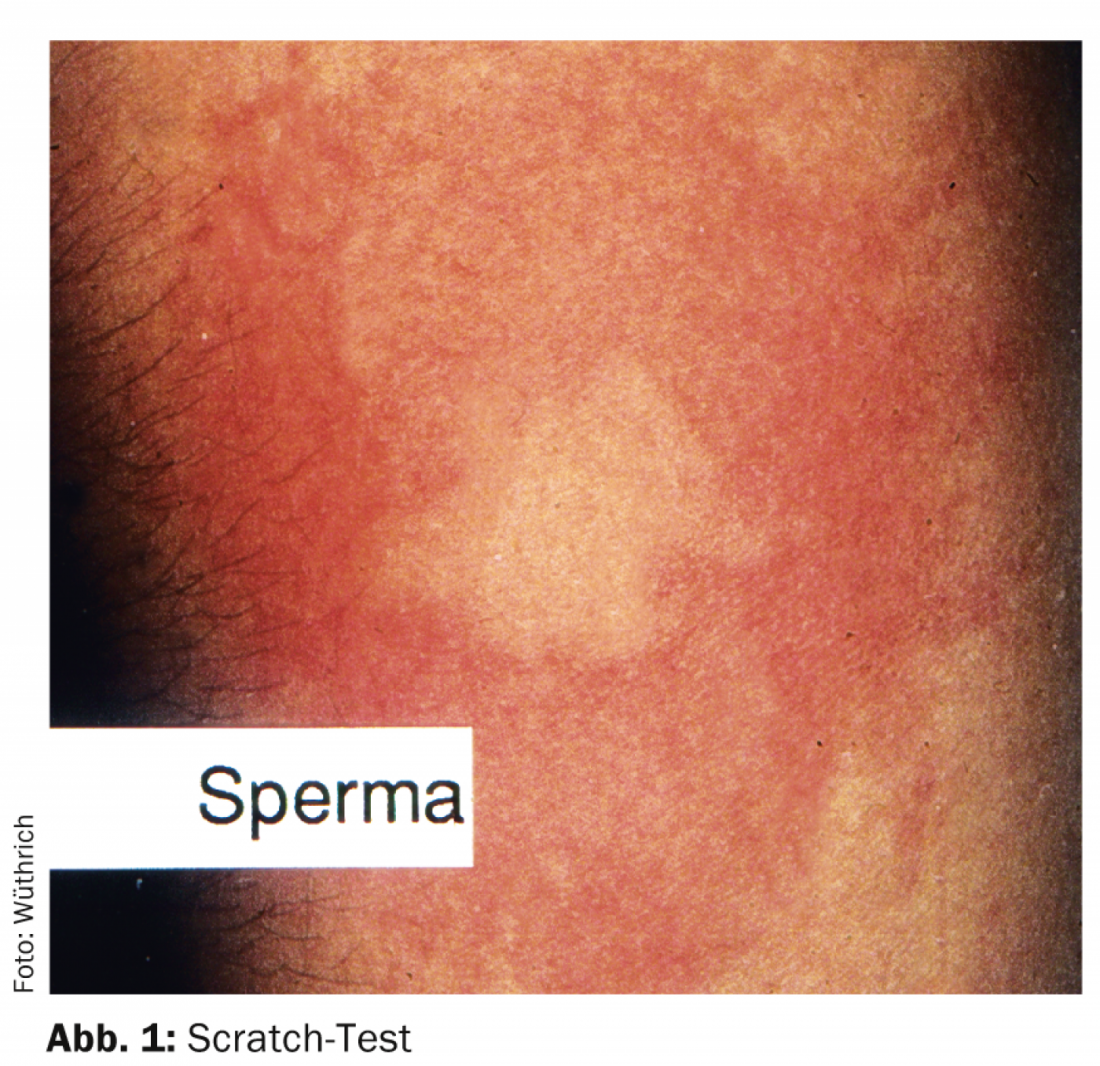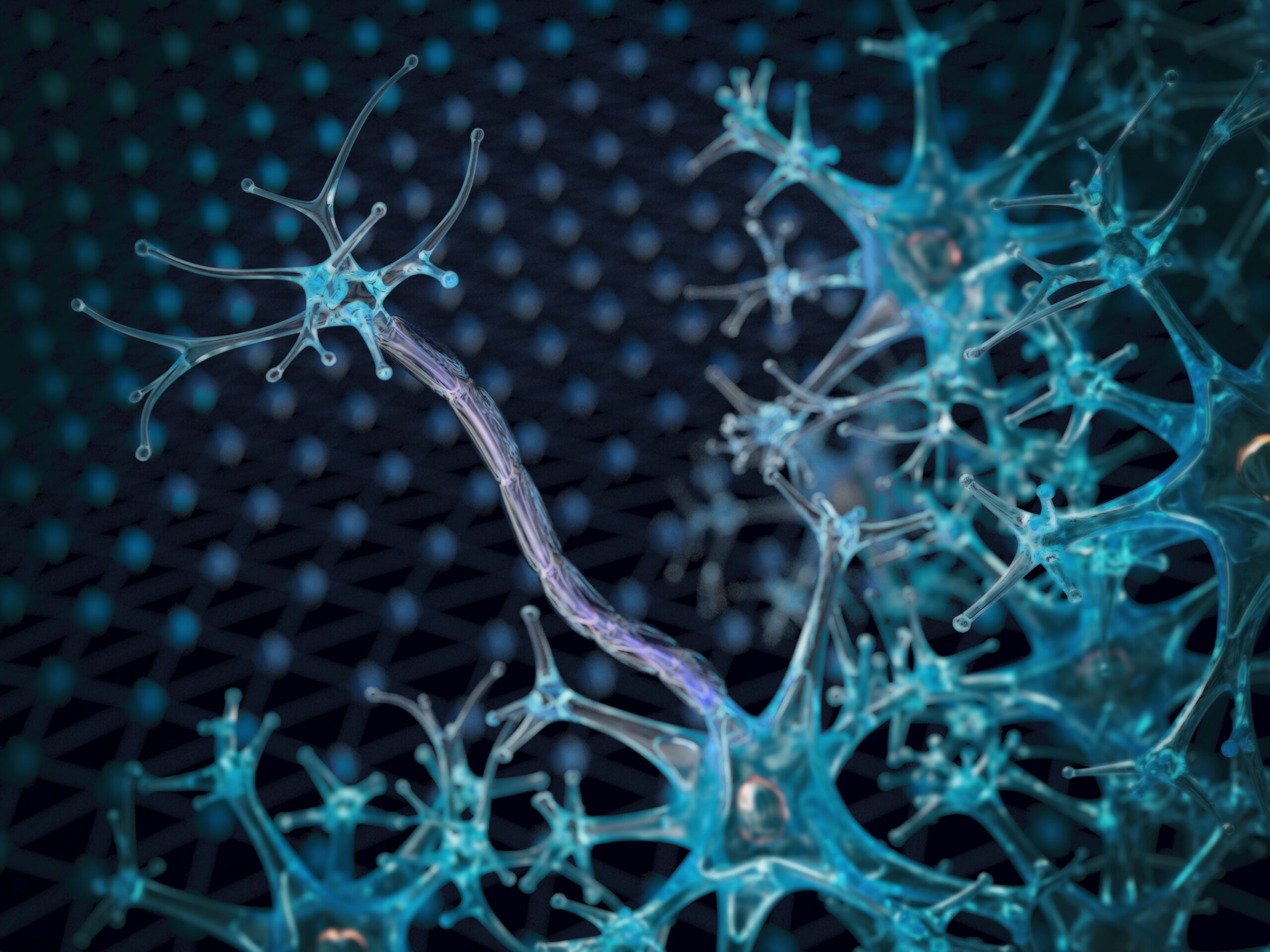Daniela, who is not yet sixteen and lives in Ticino, suffered from allergic bronchial asthma as a child. Recently, acute attacks of generalized urticaria with Quincke’s edema of the eyelids and asthma occurred several times, each time requiring a visit to the emergency department of the nearby hospital.
Medical history
The seizures occurred mostly on weekends or during going out and not in association with food intake or concurrent physical exertion. General practitioner, internal medicine and allergology examinations remained fruitless, so that the Ticino doctors were faced with a mystery. After a new attack, the dermatologist referred the patient – under the diagnosis of “idiopathic anaphylaxis” – to the allergy ward of the Dermatology Clinic, Zurich University Hospital. Again, extensive allergologic and immunologic workup, including testing for latex allergy, mastocytosis, and carcinoid syndrome, were negative (except for positive prick tests with various pollens and feline epithelia). So the assistants made an appointment with the patient for the “chief visit.” On this occasion, I asked the adolescents to wait until the end of the chief resident’s visit because I wanted to have a private conversation. It was only during the conversation in Ticino dialect that Daniela admitted that the seizures always occurred during or following unprotected sexual intercourse, or even only during contact with seminal fluid, and even with different partners, but not during coitus condomatus. Fearing her parents’ reaction, the teenager concealed this information from doctors. Since the patient was accompanied to Zurich by her boyfriend, a scratch test with semen fluid could subsequently be performed, which was strongly positive (Fig. 1) . The RAST test (o70 Phadia, now ThermoFisher) with semen was class 3 positive, with latex (k82) negative.

Diagnosis
Sperm allergy of anaphylactic type in a female atopic.
Comment
Allergy to semen was first described in 1958 by the Dutch gynecologist Specken [1]. This very rare sperm allergy is still a relatively unknown form of allergy even among physicians. In a 2004 review, 80 cases were found in the Anglo-Saxon literature [2]. Mostly young atopic women are affected; the symptoms can often manifest themselves at the first contact with seminal fluid.
Sperm allergies are local or systemic allergic reactions of the immediate type, IgE-mediated, to protein components of human seminal plasma; the sperm themselves are not allergenic [2,3]. Itching, burning, erythema, and edema in the vulvar area or other sites of semen contact may begin immediately or with a short time delay (up to 30 min). Generalized systemic reactions manifest as generalized urticaria, angioedema, rhinoconjunctival symptoms, dyspnea, gastrointestinal symptoms with vomiting or diarrhea, exacerbation of preexisting atopic eczema, or anaphylactic shock [2,3]. Affected women notice quite quickly that they have discomfort every time after contact with semen and it does not help to change partners. No reactions were observed to partner saliva. The allergenic potential emanates from proteins contained in the semen and is the same in every man [2]. They are mostly basic glycoproteins derived from the prostate, with molecular weights variously reported in the literature between 1200 and 40 000 daltons [2–4]. Proteolysis results in the loss of antigenicity. A research group has succeeded in identifying the allergen as the prostate-specific antigen (PSA) [5]. A striking feature of sperm allergy is the high proportion of women who notice symptoms against sperm already after the first intravaginal sexual intercourse. From this, on the one hand, the presence of a cross antigen can be concluded. Kofler et al. [6] report on a 22-year-old female patient who complained for several months of local symptoms with redness, swelling of the eyelids, intense itching, and occasional asthmatic symptoms that occurred briefly after coitus without a condom. Furthermore, allergic seasonal rhinoconjunctivitis as well as contact urticaria when touching dogs were known, although this only occurred when contact was made with male dogs. The contact with the female dog of the parents never caused any problems. The cross-reactive allergen identified was Can f5, an argininesterase typically detected in the fur and urine of male (not female) dogs and exhibiting cross-reactivity against prostate-specific antigen (PSA) [6]. Another possibility is that patients reacting during sexual intercourse were sensitized by extravaginal sperm exposure even before cohabitation.
To confirm the diagnosis of seminal fluid allergy, specific IgE to seminal plasma (o70 Phadia, ThermoFisher) and a skin prick or scratch test can be performed with the seminal plasma fluid. Differential diagnosis must exclude latex allergy (condoms), allergy to lubricants and local anesthetics (in some condoms), and allergy to spermicidal substances in vaginal contraceptives. A very rare form of “connubial allergy” represents an allergy caused by drugs (e.g., penicillin) or foods transmitted via semen during sexual intercourse [7]. The triggering food was first identified as Brazil nut, which the boyfriend had consumed before having sexual intercourse with the girlfriend, who was highly allergic to nuts. Prick test with semen after Brazil nut ingestion was positive, but negative before ingestion [8].
Therapeutically, the primary recommendation is to always use a condom during sexual intercourse. Systemic antihistamines (high dose) and topical 4-8% cromoglycine-containing creams may also be recommended before sexual intercourse. If you wish to have children, intrauterine insemination with washed spermatozoa can be tried. In this case, however, testing with the spermatozoa suspension is recommended beforehand, as these may have seminal plasma residues bound to the surface. Alternatively, in vitro assisted reproduction procedures must be considered. Success of hyposensitization with chromatographically separated seminal plasma fractions has also been reported, with subcutaneous injections of the allergologically relevant fractions three times a week for a period of about four months. To maintain tolerance, unprotected intercourse should then occur every two to three days. Ultrarush desensitization under steady-state conditions was also successful in five of six cases [9]. A Korean group further reported successful intravaginal rush desensitization with subsequent spontaneous pregnancy and birth of a healthy child [10].
Allergy to own sperm
An allergic reaction of males to foreign human sperm has not yet been observed, but may occur to sperm of other species [11]. Men, on the other hand, can be allergic to their own semen, which is called “post-orgasmic illness syndrome” (POIS). POIS was first described in 2002 by Dutch psychiatrists Marcel D. Waldinger and Dave H. Schweitzer [12]. Some men feel very sick after sexual intercourse – and this is not a psychological problem: they are allergic to their own sperm and react after ejaculation with flu-like or allergic symptoms such as fever, runny nose, burning eyes and fatigue, which start within a few minutes and can last up to a week [12]. In a follow-up study, 45 men with POIS were further investigated in the Netherlands. With the leakage of semen after masturbation, the symptoms of the disease also began, sometimes even within a few minutes. Of the men studied, 33 underwent skin allergy testing with their own semen, and 29 (88%) showed a positive immediate reaction. Two volunteers underwent hyposensitization therapy, and after a treatment period of three years, symptoms decreased significantly.
Literature:
- Specken JLH: Een merkwaardig geval van allergi in de gynaecologi. Ned [Ein merkwürdiger Fall von Allergie in der Gynäkologie]. Tijdschr Verloskd Gynaecol 1958; 58: 314-318.
- Shah A, Panjabi C: Human seminal plasma allergy: a review of a rare phenomenon. Clin Exp Allergy 2004: 34: 827-838.
- Altmeyer P: Sperm allergy. www.enzyklopaedie-dermatologie.de/login/n/h/15308_1.htm. Springer-Verlag 2014.
- Boit R, Manns S, Hartmannr M: Sperm allergy – two casuistics. Dermatology in Occupation and Environment, 2004; 52: 1Q: 33-35.
- Weidinger S, Ring J, Köhn FM: IgE-mediated allergy against human seminal plasma. Chem Immunol Allergy 2005; 88: 128-138.
- Kofler L, et al: A case of dog-related human seminal plasma allergy. Eur Ann Allergy Clin Immunol 2012; 44: 89-92.
- Wüthrich B: Food allergies – part 2. Allergens can be transferred with the saliva of the partner. The “derivative allergy”: a rare food allergy trigger pathway. DERMATOLOGIE PRAXIS 2013; 5: 5.
- Bansal AS, et al: Dangerous liaison: sexually transmitted allergic reaction to Brazil nuts. J Invest Allergol Clin Immunol 2007; 17: 189-191.
- Drouet M, et al: Thirteen cases of allergy to human seminal plasma. Allergy 1997; 52: 112-114.
- Park JW, et al: Seminal plasma anaphylaxis: successful pregnancy after intravaginal desensitization and immunodetection of allergens. Allergy 1999; 54: 990-993.
- Waldinger MD, Schweitzer DH: Postorgasmic illness syndrome: Two cases. Journal of Sex & Marital Therapy 2002; 28: 251-255.
- Weidinger S, et al.: IgE-mediated allergy against human seminal plasma. In: Chem Immunol Allergy. 2005; 88: 128-138. PMID 16129942.
DERMATOLOGIE PRAXIS 2014; 24(4): 30-31
DERMATOLOGIE PRAXIS 2018 Special Edition (Anniversary Issue), Prof. Brunello Wüthrich












